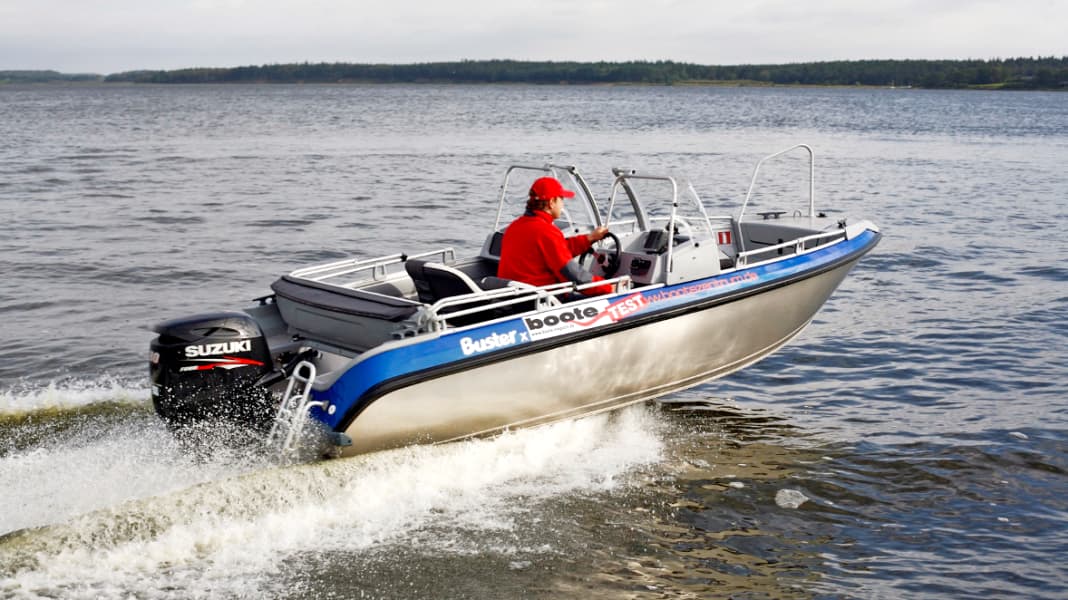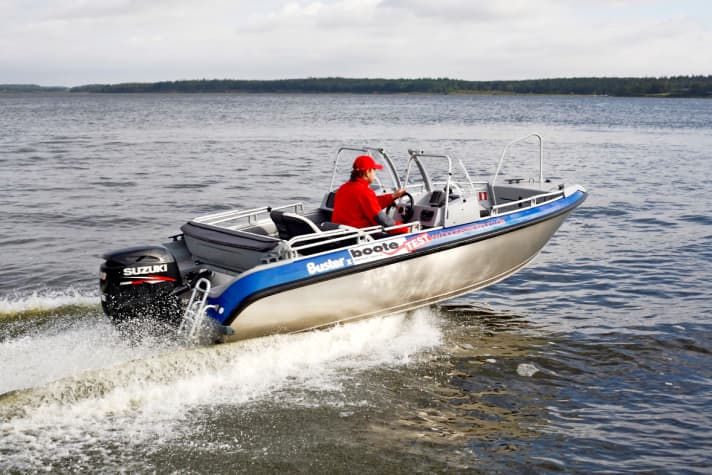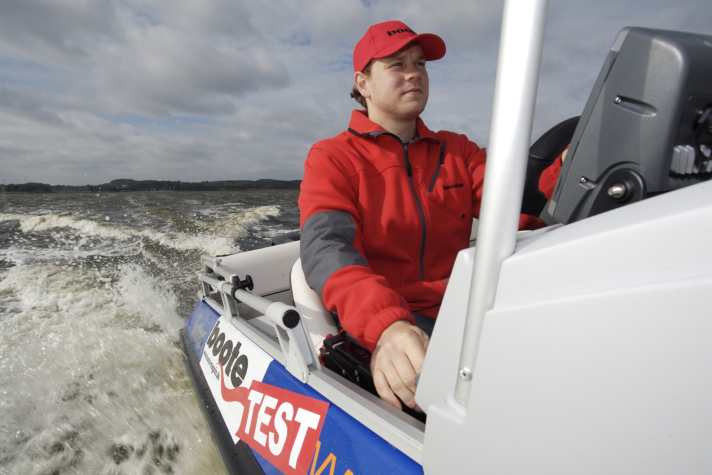

Due to their solid metal construction, aluminium boats generally have the reputation of being for anglers, divers and commercial purposes or aid organisations such as the fire brigade and DLRG. Cold-looking surfaces and hard edges are the most common negative points that women mention when they see such a boat.

The designers at Buster recognised this and gave it a cosier flair with attractive plastic cockpit furniture and decorative strips, giving the boat plenty of seats and storage space for a trip with family or friends for swimming, water skiing, picnics or exploring the area. The highlight: the benches can be removed in just a few simple steps, giving you space to transport floats and lines for a buoy field, for example. It is also easy to carry diving tanks.






Transporting the boat is also no problem. With a weight of around 650 kg including the test engine, you need a trailer with a maximum total mass of 1200 kg, which is easily towed by a Golf and the like.
For mobility on the water, a maximum of 80 hp is allowed at the transom. Our test engine, a DF80 from Suzuki, had exactly this power. Read in BOOTE 4/12 how it compares with the smaller DF60. If you want to go waterskiing or wakeboarding, a quick transition from displacement to planing speed is important. Our test boat without a runner manages this in no time at all with only a brief obstruction to visibility.
If you forget to trim the power trim all the way to the transom, you will need noticeably more time for the acceleration phase and will have the bow in your field of vision for about 4 seconds until the buster reaches planing speed while rocking. She glides well from 3500 rpm (16.2 knots). This speed is also the most economical speed.
In figures, this means 0.55 l/sm consumption and, with the standard 72-litre built-in tank, a range of a remarkable 112 nm plus 15% reserve. Even at full throttle at 6000 rpm (a good 33 knots) and a fuel consumption of 0.86 l/sm, the Buster-Suzuki combination still achieves 12 nm more than the 60 nm required by us.
The boat runs stable over the entire planing range and only produces a flat stern wave. The maximum trim on our test boat is around 3/4 on the display. If you overdo it with the trim, you will notice a slight bobbing. If you leave the trim on in tight bends and roundabouts, the Buster reacts with an air-snapping propeller and you have to start again.
When the power trim is set to "down", as is usual in tight bends, the fuselage pulls into the bend without rocking or hooking and leans heavily onto its side at the tightest point. The steering always remains smooth and precise during this manoeuvre, on slalom courses and when tearing away. In the last two manoeuvres mentioned above, the boat handles safely and relaxed with and without trim.
The same applies to harbour manoeuvres, where the Buster X makes tight circles and turns directly. It is in the nature of things and not unusual that the 4 Beaufort wind on our test day had a strong influence on the manoeuvres mentioned and that we had to juggle with increased idle speed. The test boat coped with choppy waves on the Schlei smoothly and dryly.
To ensure that the driver is always relaxed and safe, the shipyard has installed a comfortably upholstered bucket seat that can be pushed and swivelled. An identical seat can be found on the passenger side. The side rails or a handle above the glove compartment provide support here. The sports steering wheel and single-lever gearstick are also praised for being precise and easy to reach.
The only drawback: when driving in a standing position, the distance between the seat and steering wheel is only large enough despite the seat being pushed all the way back. Apart from the fuel gauge (partially covered by the steering wheel), the instruments are easy to read. Minus: The compass costs extra.
The electrical system consists of an easy-to-operate rocker switch and 12 V socket on the driver's platform, navigation lights (European approval) and 95 Ah battery in a box with a retaining strap, easily accessible main switch and automatic machine in a splash-proof box.
The technicians bolt the tank securely under the outboard hull. Apart from the missing stopcock, the rest of the tank system with fixed fuel hose connections and standard filter cartridge is praised. The pipe routing and overall aluminium and fixture workmanship are also expert.
In terms of safety equipment, the shipyard saves on a manual bilge pump, but otherwise there is nothing to criticise in this category with a self-draining cockpit, electric bilge pump and manual fire extinguisher. Movement safety is not neglected either with non-slip floor structures and suitable handrails. Buster has provided a sufficiently wide bathing ladder so that you can climb back into the boat after a swim.
The shipyard has integrated a self-draining box in the front deck mould for the anchor. Next to it is a "fat" eyelet, which is intended for chaining the boat to prevent theft. The boat is moored to four cleats that match the boat; fenders are attached to the railing. A sturdy, thick, black plastic moulding provides all-round protection.
Conclusion: The Buster X is a well thought-out, easily trailerable boat in the 5 m class with good driving and manoeuvring characteristics.
Data sheet: Buster X
Shipyard: Buster
Type designation: Buster X
CE category: C - Coastal waters
Material of hull and deck: Plastic
Length: 5,15 m
Width: 2,06 m
Displacement: 0,48 t
Price: 28.370,00 €

